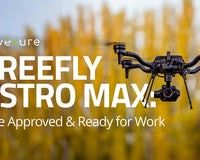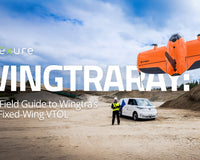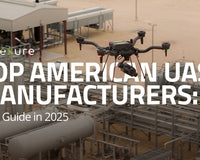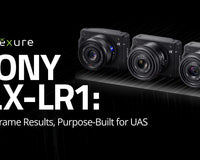Across industries like surveying, construction, asset inspection, conservation, and film & gaming, stakeholders no longer settle for coarse surface models—they expect realistic, data-rich 3D models that can be measured, annotated, and shared in minutes.
DJI Terra V5.0 rises to that challenge with Gaussian Splatting, a new next-generation rendering approach that turns ordinary image sets into photo-realistic models faster and with more detail than traditional photogrammetry.
Terra has come a long way since its 2018 debut, adding full 3D reconstruction, LiDAR processing, and integrated mesh-cleanup tools along the way. V5 builds on that foundation, introducing Gaussian Splatting, an upgrade that promise sharper vegetation restoration, cleaner reflective surfaces, and accurate portrayal of finer structures like power lines.
In this edition of Advexure Insider, we’ll break down Gaussian Splatting, where it outperforms classic photogrammetry (and where it doesn’t), and what this all-new DJI Terra version mean for your workflow.
What Is Photogrammetry?

A quick recap. Photogrammetry is the practice of turning a series of overlapping images into survey-grade maps or 3D models.
By analyzing how features shift from one photo to the next, software can calculate both their real-world dimensions and geographic position, producing outputs such as orthomosaic maps, GIS layers, point clouds, and textured 3D scenes.
Most projects fall into two camps: aerial photogrammetry, where a drone or aircraft shoots straight-down (nadir) photos of the landscape, and close-range photogrammetry, which captures objects like facades or cultural artifacts from a short distance.
Under the hood, today’s mapping engines use techniques like Structure-from-Motion to align images, generate a dense point cloud, wrap it in a surface mesh, and finally “paint” the model with photo-realistic textures. The process is remarkably accessible (plan a flight, collect high-overlap imagery, and let the computer do the heavy lifting) yet it still requires careful execution: balanced altitude and speed, nadir camera angle, proper exposure, and 70%–90% image overlap are all critical for clean results.

Even with the best execution, traditional photogrammetry has its pain points. Dense vegetation can leave holes or fuzzy canopies, reflective surfaces (glass, water, metal roofs) often confuse the algorithm, and fine structures like power lines may deform or disappear.
Large projects can also bog down workstations, stretching processing times from hours to days.
Why Gaussian Splatting Is a Different Animal
Most survey-grade models are still built the “mesh way”: thousands (or millions) of triangles stitched over a dense point cloud, then textured to resemble reality.
Gaussian Splatting flips that script. Instead of forcing the real world onto flat facets, it represents every part of a scene as a tiny Gaussian ellipsoid—a fuzzy 3D blob with values for position, size, orientation, and color.

Pack enough of these ellipsoids together and they blend into surfaces, fine cables, glass façades, even tree canopies, without ever resorting to hard edges.
How the Pipeline Works (Mesh vs. Splats)
|
Step |
Traditional Photogrammetry |
Gaussian Splatting |
NeRF-Style Rendering |
|---|---|---|---|
|
1. Capture |
High-overlap photos |
Same photos |
Same photos |
|
2. Camera Recovery |
Structure-from-Motion (SfM) solves poses |
Same SfM |
Same SfM |
|
3. Initial Geometry |
Dense point cloud (millions of XYZ points) |
Sparse SfM cloud → seed ellipsoids |
None |
|
4. Surface Creation / Training |
Triangulate → mesh → texture |
Gradient descent refines ellipsoids (no mesh) |
Gradient descent trains an MLP |
|
5. Lighting & Color |
Static texture |
Spherical harmonics per ellipsoid (view-dependent) |
Radiance learned by network |
|
6. Output & Play-back |
Heavy OBJ/FBX mesh |
Lightweight GS file (real-time GPU raster) |
Tiny network file but slow ray-march render |
|
7. Editing |
Direct vertex edits |
Move / split / delete ellipsoids |
Requires network retrain |
Key idea: Because Gaussians are continuous and differentiable, the optimizer can gently nudge each splat until the rendered view matches every input photo—no mesh cleanup, no neural inference farm.
Glossary of Key Terms
|
Concept |
Definition |
|---|---|
|
Gaussian Ellipsoid |
A 3-D “bell curve”—densest at the center, fading outward. Overlapping curves approximate any shape, from brick corners to spider-web cables. |
|
Structure-from-Motion (SfM) |
Finds camera positions by matching features across photos; also spits out a rough point cloud. |
|
Gradient Descent |
Render → compare to photo → tweak splats → repeat. Blurry blobs sharpen into accurate geometry automatically. |
|
Spherical Harmonics |
Math shorthand that lets each splat store how its color/brightness changes with view angle—critical for glass and water. |
|
Radiance Field |
“How light exits every point in every direction.” GS stores this locally in each splat, so reflections shift naturally as you orbit. |
|
Differentiable Rasterizer |
GPU routine that outputs both pixel colors and gradients, enabling the optimization loop. |
Where Gaussian Splatting Really Shines
|
Benefit |
Field Impact |
|---|---|
|
Fine-Structure Fidelity |
Power-lines, antenna wires, rebar—no “melting” into the mesh. |
|
Reflective / Transparent Surfaces |
Windows, water, polished metal keep real reflections—no texture smears. |
|
Color & Lighting Realism |
View-dependent shading means VFX-ready renders straight out of Terra. |
GS vs. NeRFs
Neural Radiance Fields (NeRFs) store everything inside a neural network. They look stunning but require GPU-heavy ray-marching and are painful to edit. GS offers a middle ground:
-
Explicit geometry (like meshes)
-
Photoreal lighting (approaching NeRF quality)
-
Real-time playback on ordinary GPUs
Example Workflow: From Matrice 4E Flight to GS Model
Scenario: A DJI Matrice 4E flies a Smart 3D Capture mission over a substation. You want a photoreal model with accurate wiring and shiny insulators.
-
Mission Planning in Pilot 2
-
Choose Smart 3D Capture → set overlap ≥80 %, altitude to clear all conductors.
-
The drone auto-orbits and tilts gimbal for nadir + oblique coverage.
-
-
Data Transfer
-
Land → pop the SSD → import imagery into DJI Terra V5.0.
-
-
Initial Processing
-
Terra runs SfM to solve cameras and generate a sparse point cloud.
-
You preview tie points to confirm coverage.
-
-
Select Reconstruction Type
-
In the new dropdown, choose Gaussian Splatting instead of “Photogrammetry (Mesh).”
-
-
Set Quality & GPU
-
Pick High (adds adaptive densification and more SH coefficients).
-
Assign local GPU or Terra Cluster if you’ve licensed it.
-
-
Optimization Loop (Auto)
-
Terra seeds one ellipsoid per SfM point, launches differentiable rasterizer, and begins gradient descent.
-
You can monitor loss-curve and splat count; Terra auto-splits or prunes ellipsoids where needed.
-
-
Preview & QA
-
Real-time viewport lets you orbit the splat model at 60 fps.
-
Check wire sag, insulator glare, and vegetation realism; flag any gaps for optional reflight.
-
-
Export / Share
-
Output .gsplat or .ply for downstream VFX, GIS, or VR streaming.
-
Optionally auto-generate an orthomosaic—GS produces a distortion-free ortho by projecting splats, no mesh required.
-
Looking Ahead to Terra V5
All of this happens inside the same interface Terra users already know—no third-party renderers, no scripting. Next, we’ll dive into the practical gains you’ll see in real datasets and the situations where classic photogrammetry still has an edge.
Benefits of Gaussian Splatting

Photogrammetry’s triangle-mesh workflow has served the industry for years, but its surface-only mindset leaves gaps—literally and figuratively—when scenes get complex. Gaussian Splatting approaches the same data as a living radiance field, so geometry, color, and lighting behave more like the real world.
|
Benefit |
Why It Matters |
Use Case Example |
|---|---|---|
|
Fine-Structure Accuracy |
Sub-centimeter features hold their shape instead of “melting” into faceted meshes. |
Power-line sag checks, antenna cables, steel rebar in bridge inspection. |
|
Reflective & Transparent Surfaces |
View-dependent shading locks reflections to the correct angle—no smeared textures or black holes. |
Glass curtain walls on high-rises, water in flood-plain models, polished metal tanks. |
|
Color & Lighting Realism |
Low-order spherical harmonics let highlights and shadows shift naturally as you orbit the model. |
VFX set scouting, AR/VR scene integration, marketing fly-through videos. |
Other Key Advantages
-
Vegetation Fidelity – Leaves and needles render with volumetric depth rather than “salad-bowl” blobs, improving canopy analysis.
-
City-Scale Efficiency – Millions of splats stream at interactive frame rates; no need to decimate or tile giant meshes for urban twins.
-
Lightweight Exports – GS files are typically one-half to one-third the size of comparable OBJs, easing cloud delivery and mobile viewing.
-
Direct Editing – Splats are explicit objects: move, delete, or recolor individual ellipsoids without retraining a neural network or remeshing.
-
Distortion-Free Orthomosaics – Because splats already store radiance continuously, Terra can project them to a 2-D plane without the waviness sometimes seen in mesh-derived orthos.
Where Classic Photogrammetry Still Wins Out
|
Photogrammetry Advantage |
When It’s the Better Choice |
|---|---|
|
Close-Up Dimensional Precision |
Crack mapping, bolt measurements, or any task requiring sub-millimeter edges at inspection distance. |
|
Legacy Deliverables & Specs |
Projects that legally mandate OBJ/FBX meshes, LAS point clouds, or specific ortho-tile formats. |
|
Well-Worn Workflows |
Teams with mature QC pipelines, CAD integrations, and regulatory approvals built around traditional meshes. |
|
Ultra-Light Hardware Needs |
Basic laptops without a modern GPU can still view decimated meshes, whereas real-time GS viewing expects at least modest graphics horsepower. |
In short, Gaussian Splatting excels whenever realism, reflectivity, or fine detail drive project value, while tried-and-true photogrammetry remains a safe bet for dimension-critical inspections and legacy-spec deliverables.
Ideal Use-Case Scenarios for Gaussian Splatting
Architecture, Engineering & Construction (AEC)

Virtual Design and Construction teams increasingly rely on photoreal BIMs to coordinate trades, verify as-built conditions, and wow clients. Gaussian Splatting preserves crisp edges on façades while accurately rendering reflective glass and polished stone, so clash-detection walk-throughs feel like standing on-site—without exporting multi-gigabyte meshes.
Substation Inspection

Electrical utilities need to see every insulator flange and cable sag without sending crews into dangerous scenarios. Because Gaussian Splatting keeps fine conductors intact and handles metallic glare, engineers can zoom in on millimeter-scale hardware, annotate issues, and share real-time views with maintenance teams.
Dense Vegetation Surveys

Foresters and environmental consultants struggle with photogrammetry “salad bowls” that turn leafy canopies into solid blobs. Volumetric splats capture individual branches and leaf clusters, enabling more accurate biomass estimates, habitat studies, and line-of-sight analyses along overgrown rights-of-way.
Heritage & Historical Conservation

When documenting fragile ruins or ornate interiors, conservationists need faithful color, subtle relief, and minimal surface contact. Gaussian Splatting’s view-dependent shading reproduces patina and weathering that flat textures mute, producing archival-quality models suitable for virtual tourism, restoration planning, and long-term digital preservation.
Smart-City 3D Models

Urban planners, utility operators, and public-safety agencies increasingly lean on city-scale models for scenario testing. Splats stream smoothly at interactive frame rates, so miles-wide downtown cores load on standard GPUs without tile management, while reflective windows and traffic-signal cabling remain true to life.
Film, Game & Virtual Production

Studios chasing real-world sets in realtime engines often face a trade-off: photogrammetry looks flat and NeRFs are hard to edit. Gaussian Splatting slots neatly in between—editable like a mesh yet photo-realistic enough for dynamic lighting—so art teams can drop a scanned back-alley or heritage courtyard straight into Unreal or Unity and start shooting.
Licensing & Pricing at a Glance
DJI Terra License Plans
|
Feature |
Standard |
Flagship |
Cluster |
Education |
|---|---|---|---|---|
|
Agricultural Application |
✓ |
✓ |
✓ |
✓ |
|
2-D Map Reconstruction (Field / Fruit Tree) |
✓ |
✓ |
✓ |
✓ |
|
2-D Map Reconstruction (Urban) |
✓ |
✓ |
✓ |
✓ |
|
2-D Multispectral Reconstruction |
✓ |
✓ |
✓ |
✓ |
|
3-D Mesh Reconstruction |
✓ |
✓ |
✓ |
✓ |
|
LiDAR Point-Cloud Reconstruction |
✓ |
✓ |
✓ |
✓ |
|
Terrain Result |
✓ |
✓ |
✓ |
✓ |
|
Gaussian Splatting |
— |
✓ |
✓ |
✓ |
|
Electricity Application Module |
— |
✓ |
✓ |
✓ |
|
Cluster Computation |
— |
— |
✓ |
— |
|
Bind Devices |
1 device |
1 device |
1 device + 3 nodes |
10 devices |
|
Authorization Mode |
Online / Offline |
Online / Offline |
Offline |
Online |
|
Validity Options |
1-Year or Perpetual |
1-Year or Perpetual |
Perpetual |
Perpetual |
DJI Terra Pricing
|
Plan |
1-Year License |
Perpetual License |
|---|---|---|
|
Standard |
US $1,850 |
US $5,280 |
|
Flagship |
US $3,700 |
US $10,580 |
(Cluster and Education prices vary by node count or academic agreement; contact Advexure for a quote.)
DJI Terra + DJI Modify Bundle Pricing*
|
Bundle (includes DJI Modify — Flagship) |
1-Year |
Perpetual |
|---|---|---|
|
Terra Standard + Modify |
US $2,780 |
US $7,890 |
|
Terra Flagship + Modify |
US $4,400 |
US $12,650 |
Free Trial Licenses with Hardware Purchase
|
Product / Combo |
Terra Trial License |
Bindings |
Activation Method |
|---|---|---|---|
|
Matrice 4E (M4E) |
Standard – 1 YearProcesses imagery captured by M4E / M4D only |
Unlimited |
Auto-bind |
|
M4D RC Combo |
Standard – 1 Year |
Unlimited |
Auto-bind |
|
M4T / M3E / M3T / M3M |
Flagship – 3 Months |
1 |
Auto-bind |
|
Zenmuse L2 |
Flagship – 3 MonthsIncludes full L2 point-cloud workflow; future L2 point-cloud features added free |
1 |
Auto-bind |
|
Zenmuse P1 / L1 |
Flagship – 6 Months |
1 |
Auto-bind |
|
M30 & M30T / M3D & M3TD / M4TD RC Combo / Dock 1, 2 & 3 |
No trial code |
— |
— |
Frequently Asked Questions
I already activated Terra Pro After updating to V5.0 am I automatically on Terra Standard, with no extra fees?
Yes. Just download and install the new package; your license is recognized automatically and you pay nothing for the upgrade or future maintenance.
Can I convert an online license to an offline license through DJI support?
No. DJI has discontinued the online-to-offline upgrade path. The only offline SKUs available are through authorized dealers.
I own a perpetual Terra Pro offline license but haven't updated for years. How do I move to the new Standard tier?
Have them install the latest Terra package. The software reads the existing offline license file, upgrades it to Standard, and needs no activation code.
I recently bought a Pro software upgrade package that’s still valid, but Gaussian Splatting is grayed-out. Why?
Gaussian Splatting is available only in the Flagship (and Cluster/Education) tier. Upgrade to Flagship to enable it; GS was never part of the Pro upgrade benefits.
Which Terra plans actually include Gaussian Splatting?
Flagship, Cluster, and Education. The Standard tier can run all classic photogrammetry and LiDAR workflows but not GS.
Can I still export a traditional mesh or orthomosaic after running GS reconstruction?
Yes. Terra V5 lets you choose reconstruction modes independently. You can output a mesh/orthomosaic, a Gaussian-splat model, or both from the same photo set.
Will upgrading to V5.0 break or overwrite my existing project files?
No. Legacy projects open as usual. If you want GS results you’ll re-run reconstruction, but your original meshes and orthos remain intact.
Does the upgrade affect my current device bindings or activation count?
Bindings stay exactly as they were—one PC for Standard/Flagship, one PC plus three nodes for Cluster, and so on. The V5 installer simply reads the existing license file and keeps your activations in place.
What Terra V5.0 Means for Your Projects
DJI’s latest update adds Gaussian Splatting to the Terra toolbox, giving you a choice between traditional mesh-based photogrammetry and a radiance-field approach that handles reflections, vegetation, and fine wiring with less cleanup.
The new licensing tiers map closely to typical project sizes, and legacy Pro licenses convert to Standard without fees or extra steps.
Deciding which reconstruction method to use now comes down to deliverable requirements: reach for photogrammetry when sub-centimeter edge measurements or long-standing CAD formats are mandatory.
Choose Gaussian Splatting when realism, file size, or real-time viewing matter more.
Learn more about DJI Terra here.










